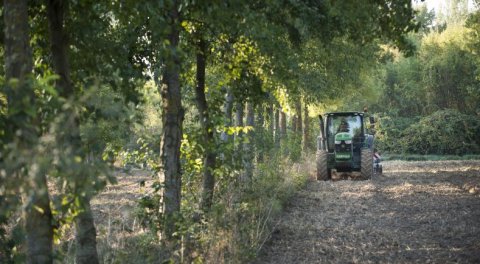Report by Claire Lemarié and Juliette Grimaldi
The Agroforestry Development Plan (2015-2020) is reaching is fifth year. Mr Christophe Pinard is policy officer for biodiversity and agroforestry at the French Ministry of Agriculture and agreed to give EURAF his opinion about this plan.
The Agroforestry Development Plan (2015-2020) was launched on 17th December 2015 by Stéphane Le Foll, the former French Minister of Agriculture, in order to support the development and the sustainable management of any agroforestry systems within the national territory. The plan is coordinated by the Ministry of Agriculture and relies on the national partners for research and development of agroforestry: the Ministry of the Environment, INRAE, CIRAD, Universities, technical institutes (INAO), Chambers of Agriculture, national organisations (Afac-Agroforesteries, AFAF), Regional Conservation Parks, etc.
The plan contained 23 actions, all focusing on five main objectives:
- Enhancing the knowledge of the diversity in agroforestry systems and of their functioning;
- Improving the regulatory and legal framework and increasing the financial supports;
- Developing the consulting, training and promotion of agroforestry;
- Sustainably improving the economic value of agroforestry products;
- Promoting and disseminating agroforestry world-wide.
Some of the results obtained from the plan are having significant positive impacts.
Firstly, a national assessment of the amount and diversity of tree hedges was set up, based on remote sensing. This project is led by the National Geographic and Forest Institute and the National agency for hunting and wildlife and will bring key knowledge on the state of agroforestry in France.
Secondly, an agroforestry section was created in the Concours Général Agricole (Paris agricultural Fair) and is widely promoting agroforestry practices.
Thirdly, the “Label Haie” was officially created on 2019 October, and is now spreading. It allows a standardized certification and recognition of sustainable tree hedge management practices. In addition, the National Institute For Origin and Quality (INAO), the National and Regional Parks and the Ministry of Agriculture are all together supporting the introduction of agroforestry in quality production specifications (ex: cider from the Regional Park of Perche, Vanilla from La Réunion National Park).
Fourthly, the Ministry supported the setting up and actions of the RMT AgroforesterieS, (2014-2019) a national network gathering 90 structures for Research, Development and Training in agroforestry. This network has been helping to arouse and coordinate new initiatives of research and development, and to share knowledge at the national scale. Finally, the Center of Agricultural Research for Development (CIRAD) together with the Ministry of agriculture have been structuring and coordinating new networks and projects of agroforestry specifically in the overseas territories of France.
Though these achievements are essential, there is still a lot to be done. That is why a second Agroforestry Development Plan (2020-2025) is about to start. According to Mr Pinard, the main issue for this second stage will consist in building regional agroforestry plans.












